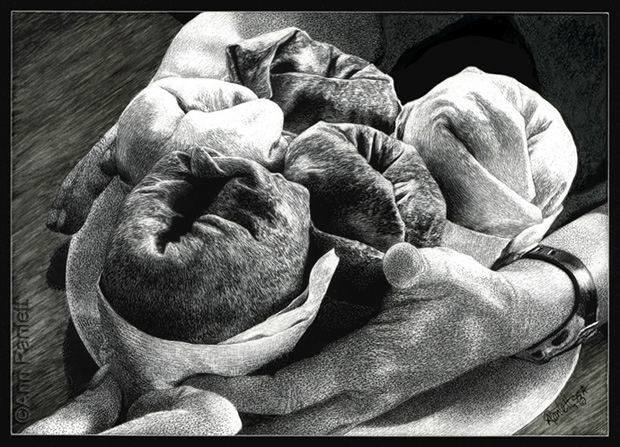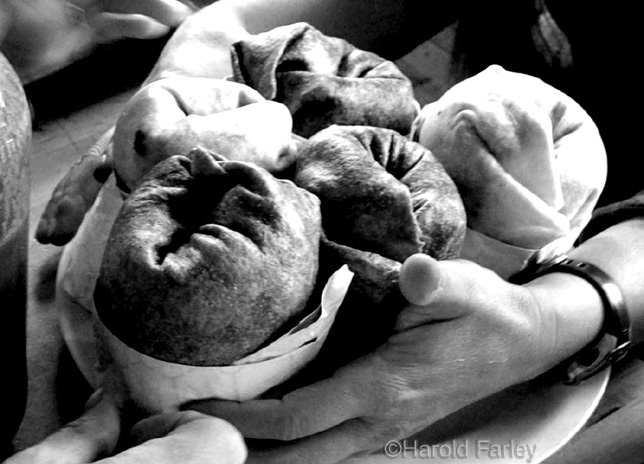I’m finally getting around to blogging the thoughts that ran through my head after wrapping up an event many months ago. I’m grateful now that I typed up all those thoughts way back when . . .A I’m able to copy/paste, edit a little, add someA photos (which I had already noted when I initially put this all together) and, zip, zoom, done! Ok, not exactly that fast, but certainly quicker than if I’d had to write this entire thing from scratch.
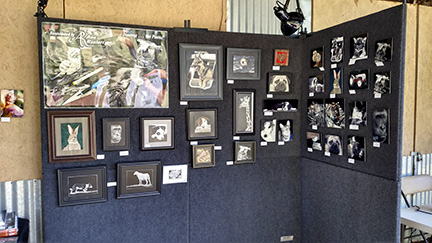 |
| – My Display at a Studios Tour Event – The poster in the upper left corner shows drawings in progress, with my hand holding a knife. You’ll see a larger version of the poster as you read along. |
I regularly participate in Open Studio events, and often an Art Walk or other event where I show my scratchboard drawings. I also have art on display at a co-op gallery (Auburn Old Town Gallery), where I work two shifts a month and often pop in.
As a scratchboard artist, I find that I spend at least two-thirds of my talking time at any venue explaining what scratchboard is. Because it’s an uncommon medium, very few people (including some artists) have no idea what it is. For artists working in other media (i.e. oil, watercolor, acrylic), the public is familiar with the media, so the artist can explain their personal techniques, favorite tools, inspiration, etc.; for me, I have to explain the basics.
When someone steps into my show booth, or sees my art on the wall, the conversations typically include the following in some combination:
Me: “This is my work. The framed pieces are original drawings, the shiny ones are reproductions on metal.”
Visitor: “Scratchboard? What’s that?” or “Wait, the “originals”. . .?” or “Those aren’t photos?” or “How do you etch on the metal?”
Me: “They’re original drawings on scratchboard, a specially prepared board. We scratch it with a knife.” “I don’t etch the metal, those are reproductions (prints) of my scratchboards, I have them made on metal instead of paper.”
Visitor: “Oh, they look like photos.” or “Wow, you drew that?”
Me: “They’re scratchboard drawings, drawn with a knife.” “Yes.”
Visitor: “Scratchboard . . . I’ve never heard of it.”
Me: “Most people haven’t. That’s why we formed a Society in 2011 to promote scratchboard as a fine art. We have an amazing annual show of nothing but scratchboard and the artists get together and geek out over scratchboard.”
Visitor: “How do you get the color on there?”
Me: “I paint it on, after the scratching. The white areas are the clay that accepts the color. I use either watercolor or colored ink.”
Visitor: “How long does a drawing take?”
Me: “At least 10 hours on a 5 x 7. But every drawing is different. It depends on the subject matter, how much of the board is covered with scratching, the textures that need to be rendered…”
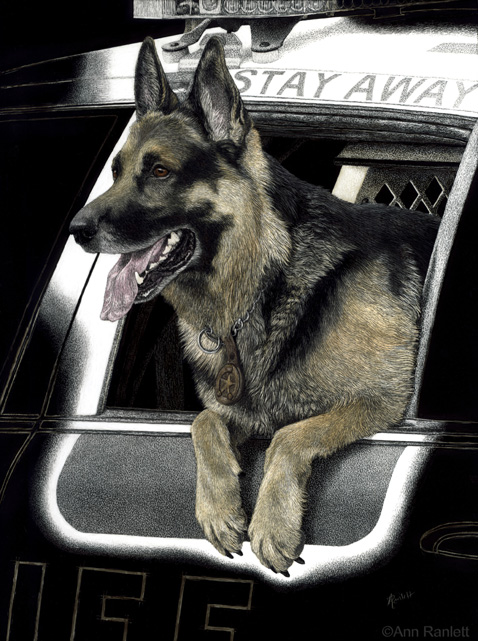 |
| “K9 Ronin” As a point of reference, the pad under Ronin’s feet took almost as much time as the dog did. Smooth surfaces take longer to draw than textured surfaces, such as hair and fur. |
Visitor: “So, it’s kinda like etching.”
Me: “It’s similar. Except a scratchboard is the final drawing, it doesn’t have to be inked and printed on paper.” (Technically, it’s more like engraving, but if someone offers up “etching”, I give them credit for making a reasonable connection and move on.)
Me: “Here, let me show you, I have a drawing in progressA . . .”
Visitor, after watching me scratch a little bit: “Wow, that’s amazing” and often, “That’s tedious.”
Me: “Thank you.” “I enjoy it, I have a degree in biology. I love animals and detail. It’s actually very Zen. I sit on the couch to draw, with my dog next to me and the tv on.”
I could go on with variations of the discussion, and I’ve probably missed a few things. . . but you get the idea.
Many visitors recall the elementary school art project of putting crayon on paper, covering that with black ink and then scratching. Fewer recall using the thin pre-made scratch paper or card-stock weight scratchboards in high school or college. I recall all of these methods. When those with the crayon/ink experience say, “I remember doing something like that in school”, I reply, “It’s similar to that, but this is the grown up, fine art version”. Others wonder how I know where to scratch to get the color. And once, someone thought I was working on a “kit” project that had an image underneath, and I was simply scratching away the top layer to reveal it.
Note that I have a sign and poster whenever I have a booth set-up, but most people still can’t wrap their head around the process without a verbal explanation/demo.
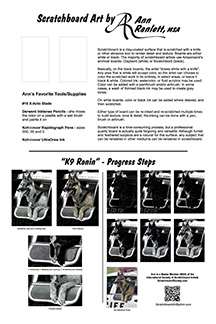
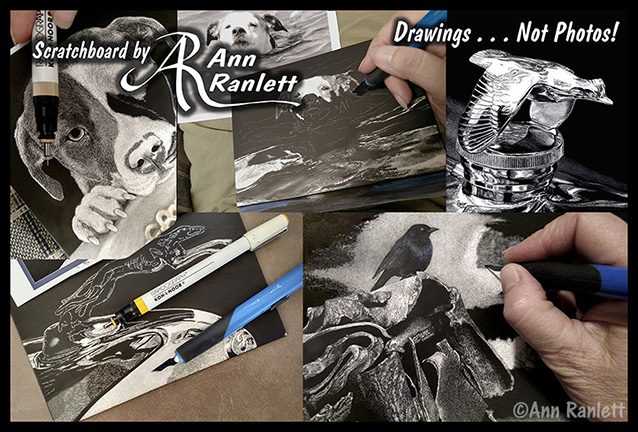
My standard phrase to explain the basic concept has long been: “I draw white with a knife.” Recently, I added “It’s not about the scratching, it’s about the drawing.” to my bag of verbal tricks. A knife is my tool, the board is my substrate. This is no different than other 2D art forms, it’s just a lot less common. Here are some thoughts in this vein, from an earlier post.
One final thought, and it’s a personal hackle-raiser: while I take the comment in the spirit it’s intended (as a compliment), I’ll admit that I’m annoyed by the frequently uttered phrase: “they look like photos”. My scratchboard drawings do not really look like photos, they’re my interpretation of a photo, and if folks took the time to look, they’d see that. I crop and scale and adjust the contrast on my reference photos, to create the version I want for a drawing. There’s generally a good deal of work before I even put the first scratch on the board. For example, this is a drawing of a plate of burritos, with one of the greyscale versions of the reference photo, cropped from a larger photo. I used a second greyscale photo that was lighter than this one, along with the color version to work out the composition and the tones I needed to come up with my vision for this piece. Click here to learn more about this drawing, “Cathy’s Burrito Bouquet”.
